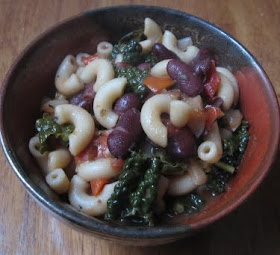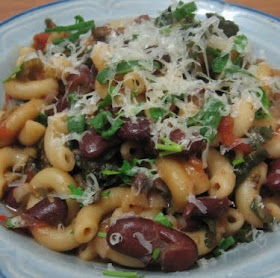More pasta! More kale! Hooray minestrone!

I was inspired by
Jennifer, who actually managed to make macaroni romantic by combining it with a very impressive-looking heritage bean mix to make the minestrone of dreams.
What, you don't dream about minestrone? Why not?
Well, I know why not: most minestrones devolve into bowls of flabby, waterlogged awfulness, tasteless yet somehow oversalted, right? I find canned minestrone particularly vile. Homemade minestrone, on the other hand, is great.
For my version, I cut out some of the more traditional soup base veg (such as carrots and celery), and instead concentrated on sturdy, high-flavor components: olives and kale. The result was excellent. In fact--full disclosure--I actually made two full batches within about three days. That means I ate minestrone for four meals in less than a week. I can't remember the last time I ate any meal that frequently. Seriously, this deserves its title.
 Excellent minestrone
Excellent minestroneshallot/onion
olive oil
tomatoes
tomato juice
olives (green and/or kalamata)
red kidney beans (or white beans, black beans, etc)
red kidney bean broth
dry vermouth
macaroni
kale
salt, pepper
cumin (yes), paprika, oregano, marjoram, basil
optional garnish: parsley, scallion greens, grating cheese
One of the keys to avoiding flabby, gross soups is to cook things from scratch, right? So start by cooking the beans from scratch. Soak the beans overnight in twice their depth of water, change the water, and boil with a bay leaf until tender and lovely, i.e. about an hour and a half. Voila: a pan of beans and broth! If you do this ahead of time, you can just put the cooked beans and broth in the refrigerator to wait a day or two. Easy.
To make the actual soup, get out a 3-quart pan and warm up a slug of olive oil. Chop up some shallots or an onion and soften it in the oil. I used two different alliums for my two batches: gigantic monster bargain bin shallots for one, and the root end of red scallions for the other. You can clearly use whatever's kicking around in your cabinet.
Chop up a few tomatoes (or use puree/etc.) and add them to the pan. Then bust out your olive stash. You totally have an olive stash in the back of the fridge! I used a green and kalamata mix, which worked nicely, but probably anything besides standard cheap black pizza olives would be fine. Pick out three or four nice specimens, crush them with the flat of your knife, remove the pits, and chop. Then just throw them in the pan with your tomatoes. Add a slug of dry vermouth, and season with salt, pepper, paprika, oregano, basil, marjoram, and a tiny bit of cumin. I know cumin sounds weird, but the effect was good! Still, you can leave it out if you want.
Give the entire business a stir and let it soften. If you want to add any other saute-oriented vegetables, such as peppers or the aforementioned carrots and celery, now is the time.
When your vegetables are soft and aromatic, it's time to add beans and liquid. I used about two cups of kidney beans, two cups of bean broth, and half a cup of tomato juice in each batch. Of course, the severe lack of measurement at my house means that this is the roughest estimate imaginable. Just use the amount that looks right to you. Bring the soup to a boil, put the lid on, and reduce the heat to simmer for ten minutes or so.
While this is all happening, boil the macaroni in a separate pan. Leave it pretty al dente, since it'll be going into boiling soup in a minute, ok?
Next, wash, de-stem, and chop a substantial handful of kale. Use more than you think you need; although kale is comparatively sturdy, it's still a green, and greens shrink. I had teeny tiny kale from the farmer's market, so small I didn't even need to cut out the stems, but this was definitely an exception.
Ok. When your pasta is done, drain it and add it to the soup. This should make the soup pretty chunky and solid, but there should still be reasonable amounts of liquid in the bottom of the pan. If not, you can always add a bit more bean broth, tomato juice, or even water; just make sure you bring it up to a boil again afterward.
Add the kale to the soup, stir, and simmer for another five minutes, or until cooked through. You can do this with the pan lid on or off; if you're hurting for liquid, keep the lid on, but if you have plenty of liquid, leave it off for maximum evaporation.

Now give the soup a final taste, correct the seasonings, and you're done. Hooray! Serve yourself a bowl, top with whatever delicacies you require, and eat with copious toast.
TASTEABLE.